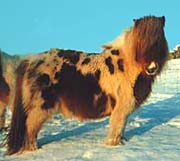Shetland Pony
N/A
Mon, 25th November, 2024 - 3:22 pm GMT
Sponsor Ads:

Alternative Name
N/ABasic Info
The Shetland pony can be seen in all colors except spotted -- black, chestnut, grey, bay, dun, blue roan, piebald or skewbald. Unlike bigger horses, measured in hands, the Shetland pony is measured by inches in height at the withers. The smallest of the British native breeds, maximum height reaches 42" with a minimum as small as 28" or so. Hardy and resilient, the Shetland is very strong for its size. It has a medium sized head, a rather dished face with a well-shaped muzzle and a jaw capable of grazing poor growth over an extensive area. The ears are medium sized and the eyes large and kindly. The coat is thick with a heavy mane and tail offering good protection against the local winter weather conditions. The action of the legs must be active and long striding to deal with local ground conditions. Up until recently the heavy black Shetland pony probably dominated the show classes outside of the Shetland Islands, due to the fact that many Shetland ponies on the British mainland may have derived from the heavy black pony exported for use in the mines. The pony preferred by the islanders was of any color and tended to be slightly lighter boned and free moving to fit in with the natural conditions
Health
N/AHabitat
N/ABehavior
Hardy and resilient.Use : Saddle, harness. The Shetland is very intelligent but can also be bad tempered. The Shetland is probably the strongest equine relative to its size, yet even the stallions are gentle and docileOrigin
Shetland IslandHistory
One of the earliest laws recorded in Shetland cautioned would-be thieves not to "cut any other man's horse-tail or main (sic)-- under the pain of ten pounds." The exorbitant fine reflects the seriousness of the crime and the Shetland dependence on their fishing and their ponies to live. Shetland ponies provided the raw materials for fishing nets and lines; fishing provided the main diet for most islanders. An old Shetland proverb states that a Orkney man is a farmer who has to fish and a Shetland man is a fisherman who has to farm. The Shetland pony bridged the gap between the two sustaining ways of life. Better documented than most breeds, the history of Shetland ponies reads like the history of the islands. At least two thousand years ago, there was a pony like the modern day Shetland pony living on the islands. Like the islanders, the pony mixed British with Viking to create a distinct Shetland type. Most likely, it was a hybrid breed, containing the blood of the British Hill type pony, like a Highland or Fell/Dale of Scotland, and a Scandinavian breed influenced by some Oriental bloodlines. The resulting pony was represented in a ninth century stone-carving found on the island of Bressay. It depicts a hooded priest riding a very small pony. On the basis of this and other archaeological finds, researchers concluded that the pony on Shetland was long domesticated. How it came to be on the islands is still a mystery. Everybody loves a good story, and some surmise that ponies arrived with the first settlers on the islands. Or it could be that shipwrecks stranded ponies from the Spanish Armada flagship, the Gran Grifton that foundered off the coast of Fair Isle. Perhaps crusaders returning from Jerusalem and Constantinople led Arabian stock back to the islands, or Viking marauders from Iceland left their signature in the white markings that characterize Shetland ponies.Common Foods
grassSponsor Ads:
Economics is the only calling in which one can have a lifetime reputation as an expert without ever once being right. -- Unknown
Shetland Pony
Coded by: BGID® | ALL RIGHTS RESERVED Copyright © 2000-2024
Disclaimer | Privacy | Report Errors / Contact | Credits



 Beware the new Naval power, they are planning to come on stream with big naval might to match their ground forces. Chinese Aircraft Carrier - Chinese Navy
Beware the new Naval power, they are planning to come on stream with big naval might to match their ground forces. Chinese Aircraft Carrier - Chinese Navy  versus
versus 
 versus
versus  This Thread is about the North Korean Military itself - the kind of army, navy, and air force they have.
This Thread is about the North Korean Military itself - the kind of army, navy, and air force they have. 
 versus
versus  versus
versus 
 versus
versus  versus
versus